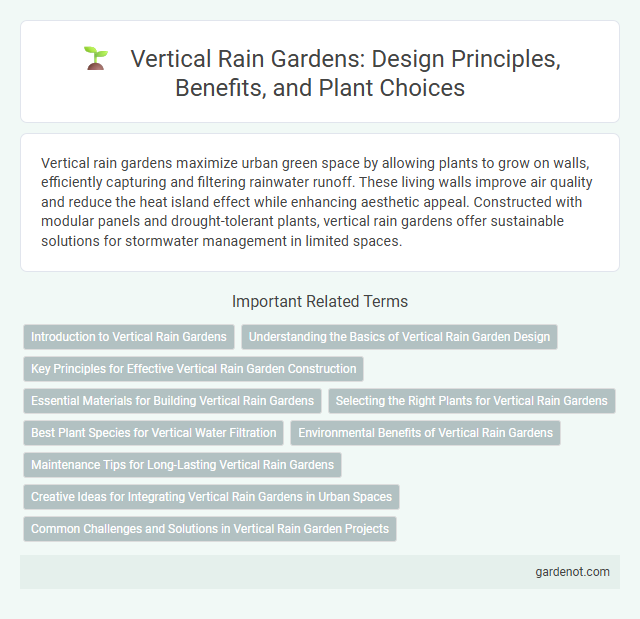Vertical rain gardens maximize urban green space by allowing plants to grow on walls, efficiently capturing and filtering rainwater runoff. These living walls improve air quality and reduce the heat island effect while enhancing aesthetic appeal. Constructed with modular panels and drought-tolerant plants, vertical rain gardens offer sustainable solutions for stormwater management in limited spaces.
Introduction to Vertical Rain Gardens
Vertical rain gardens maximize green space by integrating plant systems on walls or vertical structures, efficiently capturing and filtering rainwater runoff. These gardens promote urban sustainability by reducing stormwater pollution and enhancing air quality while adding aesthetic value to confined areas. Innovative designs often incorporate modular panels with drought-resistant native species, optimizing water absorption and minimizing maintenance requirements.
Understanding the Basics of Vertical Rain Garden Design
Vertical rain garden design maximizes green space by integrating plants on walls or other vertical surfaces to manage stormwater runoff efficiently. Essential elements include selecting drought-tolerant, native plant species, ensuring proper waterproofing and drainage layers, and incorporating irrigation systems tailored for vertical growth. Optimizing substrate depth and choosing materials with high water retention capacity enhances plant health while significantly reducing urban runoff and improving air quality.
Key Principles for Effective Vertical Rain Garden Construction
Vertical rain garden construction relies on critical principles such as selecting lightweight, water-retentive substrates that support diverse plant species and ensure efficient drainage. Proper structural support using durable frameworks like galvanized steel or treated wood maintains stability while allowing optimal sunlight exposure for photosynthesis. Integrating an efficient irrigation system tailored to the vertical layout maximizes water retention and minimizes runoff, enhancing urban sustainability and biodiversity.
Essential Materials for Building Vertical Rain Gardens
Essential materials for building vertical rain gardens include moisture-resistant structural elements such as treated wood, galvanized steel, or recycled plastic pallets to support plant growth and withstand weather conditions. A high-quality, lightweight growing medium enriched with organic matter and designed for excellent water retention ensures healthy root systems while preventing soil erosion. Incorporating a durable irrigation system, such as drip lines or self-watering panels, optimizes water efficiency and maintains consistent moisture levels for various plant species adapted to vertical environments.
Selecting the Right Plants for Vertical Rain Gardens
Selecting the right plants for vertical rain gardens involves choosing species that thrive in well-drained, nutrient-rich conditions while tolerating periodic moisture fluctuations. Native plants such as ferns, sedums, and ornamental grasses are ideal due to their adaptability and low maintenance requirements. Incorporating drought-tolerant and deep-rooted plants ensures structural stability and maximizes water absorption efficiency in vertical garden systems.
Best Plant Species for Vertical Water Filtration
Fern species such as Boston fern (Nephrolepis exaltata) and maidenhair fern (Adiantum) excel in vertical rain gardens due to their high water absorption and filtration capacity. Pothos (Epipremnum aureum) and spider plants (Chlorophytum comosum) thrive in vertical structures while efficiently removing pollutants from runoff water. Adding sedum varieties like Sedum album enhances filtration performance, as these succulents tolerate intermittent wetness and improve nutrient uptake in vertical garden systems.
Environmental Benefits of Vertical Rain Gardens
Vertical rain gardens significantly improve urban air quality by absorbing pollutants and releasing oxygen through their dense plant coverage. These gardens reduce stormwater runoff by capturing and filtering rainwater, which helps prevent soil erosion and groundwater contamination. Their ability to moderate urban heat islands also lowers surrounding temperatures, promoting biodiversity and enhancing local ecosystems.
Maintenance Tips for Long-Lasting Vertical Rain Gardens
To ensure the longevity of vertical rain gardens, regularly inspect and clean irrigation systems to prevent clogging and uneven water distribution. Pruning plants and replacing any damaged or diseased species helps maintain healthy growth and aesthetic appeal. Monitoring structural supports and repairing any damage promptly prevents plant loss and ensures stability.
Creative Ideas for Integrating Vertical Rain Gardens in Urban Spaces
Vertical rain gardens offer innovative solutions for urban spaces by transforming walls and narrow surfaces into lush, water-absorbing green installations. Utilizing modular panels with native, drought-resistant plants optimizes stormwater management while enhancing air quality and aesthetic appeal. Integrating smart irrigation systems and recycled materials further maximizes sustainability and urban biodiversity in densely populated areas.
Common Challenges and Solutions in Vertical Rain Garden Projects
Vertical rain garden projects often face challenges such as limited structural support, water drainage issues, and plant selection constraints due to confined soil volume. Effective solutions include using lightweight modular panels with integrated irrigation systems, selecting hardy, drought-tolerant species, and employing engineered soil substrates to optimize water retention and root growth. Incorporating automated drip irrigation and regular maintenance plans ensures sustained plant health and project longevity.
Vertical rain garden Infographic

 gardenot.com
gardenot.com